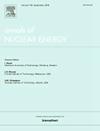Parallelization and application of SACOS-LMR for whole-core pin-by-pin thermal-hydraulic analysis in LMFRs
IF 1.9
3区 工程技术
Q1 NUCLEAR SCIENCE & TECHNOLOGY
引用次数: 0
Abstract
The liquid metal cooled fast reactor is considered a representative design for the fourth generation of advanced reactors, owing to its inherent safety features, high power density, extended refueling intervals, and compactness. Thermal-hydraulic analysis of the reactor core remains critical for both safety and economic evaluations. In this work, we implemented parallel computing capabilities in SACOS-LMR using MPI, achieving a speedup ratio of 76 and maintaining parallel efficiency above 60% for a 100-processors parallel calculation. This work successfully resolved challenges related to inter-wrapper flow (IWF) in whole-core parallel computations and validated the IWF model using experimental data from the KALLA-IWF tests. Furthermore, we conducted whole-core pin-by-pin sub-channel calculations for the ALFRED reactor, analyzing the effects of the two-step and pin-level methods, as well as IWF flow rates, on the thermal–hydraulic characteristics of the reactor core.
求助全文
约1分钟内获得全文
求助全文
来源期刊

Annals of Nuclear Energy
工程技术-核科学技术
CiteScore
4.30
自引率
21.10%
发文量
632
审稿时长
7.3 months
期刊介绍:
Annals of Nuclear Energy provides an international medium for the communication of original research, ideas and developments in all areas of the field of nuclear energy science and technology. Its scope embraces nuclear fuel reserves, fuel cycles and cost, materials, processing, system and component technology (fission only), design and optimization, direct conversion of nuclear energy sources, environmental control, reactor physics, heat transfer and fluid dynamics, structural analysis, fuel management, future developments, nuclear fuel and safety, nuclear aerosol, neutron physics, computer technology (both software and hardware), risk assessment, radioactive waste disposal and reactor thermal hydraulics. Papers submitted to Annals need to demonstrate a clear link to nuclear power generation/nuclear engineering. Papers which deal with pure nuclear physics, pure health physics, imaging, or attenuation and shielding properties of concretes and various geological materials are not within the scope of the journal. Also, papers that deal with policy or economics are not within the scope of the journal.
 求助内容:
求助内容: 应助结果提醒方式:
应助结果提醒方式:


